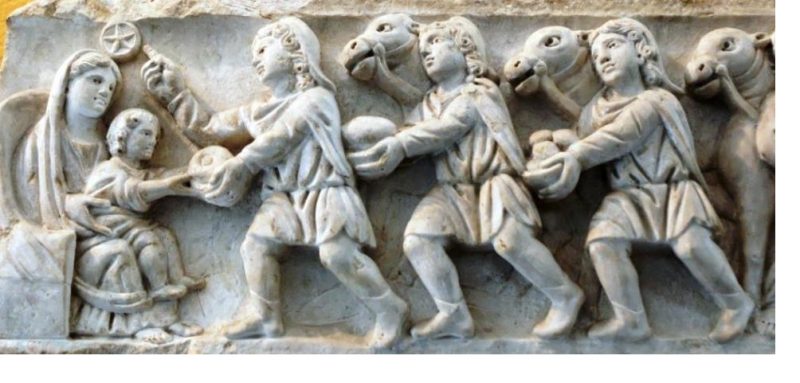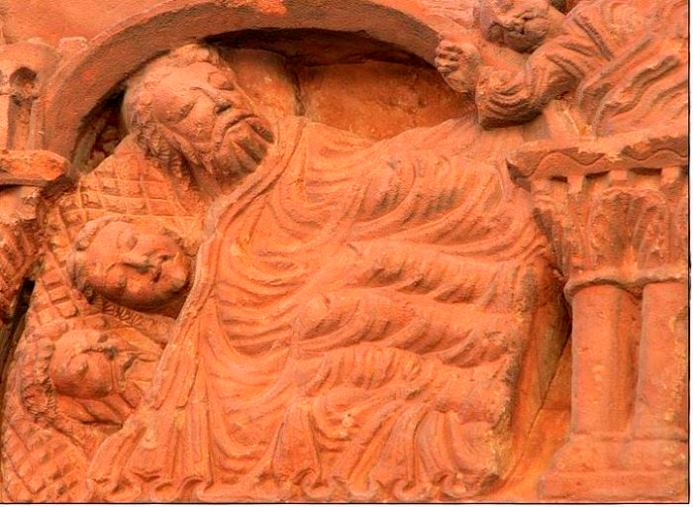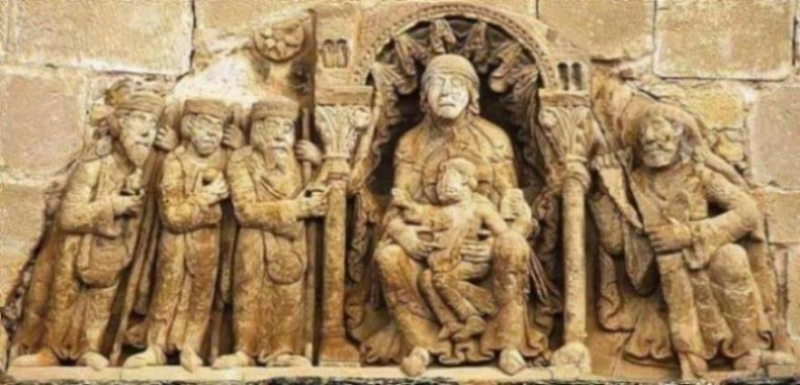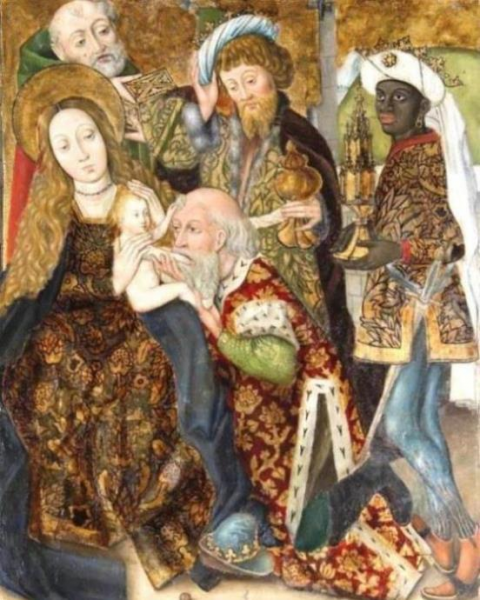
This work studies the iconography of the Adoration of the Magi in Spain during the medieval and early modern periods, under the supervision of James Amelang (UAM) and Fernando Rodríguez Mediano (CCHS-CSIC).
The importance of the arrival of the Magi from the Orient to pay homage to Jesus symbolized the universality of Christianity and the early importance of this episode is demonstrated by the Magi’s appearance in the sarcophagi of the followers of the new religion beginning in the fourth century.

IMG: Sarcófago, s. IV, Museo Pío Cristiano (Museos Vaticanos)
In the first place, this study examines the pagan elements that converge in the account of the Magi, the most important of these being the assumption that these were Zoroastrian or Mithraic priests. Following that will be an analysis of the texts recounting their supposed deeds across the centuries beginning with the Gospel of Matthew which narrates the journey of the Magi guided by the star, their meeting with Herod, the adoration and presentation of gifts, and the dream in which an angel appeared to them.
Numerous details were rapidly added to the original account to supply the greatest consistency and significance, for example in the apocryphal gospels and in the works of Justin Martyr, Origen, Saint Jerome, Tertullian, Caesarius of Arles, the Pseudo-Bede or Strabo. The supposed transfer of the relics of the Magi from Milan to Cologne in the twelfth century provided a strong boost to the myth that was also to be reinforced by the Legenda Aurea by Jacopo della Voragine and the History of the Three Kings by John of Hildesheim.
The analysis of the cited texts will be placed in parallel with the numerous works of art that have captured the circumstances of the Magi, from Late Antiquity through the creative heights of the Middle Ages and finally to the Renaissance. Analyzed here will be the diverse elements that have been present since the first representations and their evolution, transformation, and precedents: the star, the characterization of the Virgen, the attitude of the child, the clothing and features of those who at first were Persian magicians of Antiquity and later became medieval monarchs, and the appearance of the magi’s retinue. The typology of the different scenes in which the Magi-kings appear will also be studied: the journey from the East guided by the star, the meeting with Herod, the Adoration, the admonishing dream when they appeared to be sleeping, and their return journey.

IMG: Iglesia de Santo Domingo en Soria, fachada, s. XII.
An essential element of the characterization of the Magi is their origin from far away, which since the beginning has given free rein to the use of various iconographic resources to mark their exoticism: their attire, the camels and other animals that accompany them, the appearance of an African within the entourage from the Low Middle Ages in Italian circles and finally the fact that in Flanders from the fifteenth century the typical Balthasar was represented as black. This was the figure that evolved the most until the seventeenth century, always providing an excuse for painters to let loose their imagination and create a character that with his attire, in which he did not lack jewels or ornaments, stands out for his elegance and refinement including his extravagance and femininity.
The work in progress addresses the development of this cycle in the European context from the fourth century, the moment when the first scenes of the mage appear in the catacombs of Rome. It goes on to analyze the most important iconographic milestones during the Middle Ages in the European context, including the transformation of the Magi from Persians to medieval kings, which occurred from within German circles.
 IMG: Iglesia de Santa María de Uncastillo, 1135-1155.
IMG: Iglesia de Santa María de Uncastillo, 1135-1155.
The bulk of the analysis centers, nonetheless, in Hispanic territory, studied from these parameters the extant artistic production in differing mediums and formats: illumination, sculpture, painting, textiles, metalwork, decorative arts, etc. In the Romanesque and Gothic periods there are abundant images of the Magi as kings in apses, tympanum, and capitals. Between the fifteenth and sixteenth centuries it is the realm of painting that we encounter numerous important examples.
 IMG: Maestro de Osma, s. XV, Museo Arqueológico Nacional.
IMG: Maestro de Osma, s. XV, Museo Arqueológico Nacional.
In the fifteenth century there was a rapid importation of the idea of Balthasar as black from Flemish to Iberian circles. Another interesting phenomenon to be treated in this study is the vestments of the kings, in which often appear Andalusian garments and fabrics, a phenomenon clearly comprehensible in Iberian territories considering the exoticization of that which they were representing.
From the sixteenth and into the next century, saw the production of works of the highest quality and symbolic value such as those of Morales or Maíno. Velázquez specifically presented in his Epiphany a portrait of the family allo divino. Another specific case is the grandiose Adoration of Rubens to be found in Spain since 1612. The study will give special attention to these creations, placing them in relation to other works in which black figures appear and within the particular Iberian context which included the strong presence of slaves of African origin.
_________________________________________________________
En el marco del proyecto CORPI ha participado en el Congreso internacional 'La esclavitud y sus huellas', bajo la dirección de Consuelo Naranjo, directora del Instituto de Historia del Consejo Superior de Investigaciones Científicas, celebrado en la Casa de América de Madrid en octubre de 2017, con la comunicación "La hermandad de negros de San Benito de Palermo en el Madrid del siglo XVIII".
La esclavitud y sus huellas - programa
En julio de 2018 participará en el congreso internacional "Slave Subjectivities in the Iberian Worlds" organizado por el Instituto de Ciencias Sociales de la Universidad de Lisboa y la Casa de Velázquez.